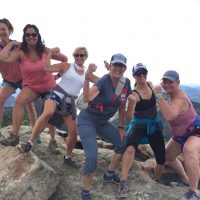 Winter can sometimes arrive with a rush, catching us off guard as our training is focused on a goal race many weeks ahead, in Spring or Summer next year. Changes in temperature and ground conditions under our feet can mean new challenges for us as runners – here are some guidelines to help keep you active, running, and healthy through the colder, shorter days of Winter.
Winter can sometimes arrive with a rush, catching us off guard as our training is focused on a goal race many weeks ahead, in Spring or Summer next year. Changes in temperature and ground conditions under our feet can mean new challenges for us as runners – here are some guidelines to help keep you active, running, and healthy through the colder, shorter days of Winter.
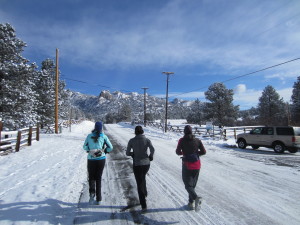 Visibility – golden rule is to make sure everyone can see you. Days when it can get dark around 4.00 pm depending on where you are means it makes sense to ensure you’re wearing at least one item of reflective clothing – a good investment if you’re going to be running outside frequently during Winter is a full on reflective vest – there are various lightweight, highly visible options available, Tuvizo have some good choices. Having a blinking light on front and back can also help to highlight you even more effectively.
Visibility – golden rule is to make sure everyone can see you. Days when it can get dark around 4.00 pm depending on where you are means it makes sense to ensure you’re wearing at least one item of reflective clothing – a good investment if you’re going to be running outside frequently during Winter is a full on reflective vest – there are various lightweight, highly visible options available, Tuvizo have some good choices. Having a blinking light on front and back can also help to highlight you even more effectively.
If you can, avoid running at dusk and dawn, as the low sun can make visibility difficult for drivers.
Run against traffic flow so you can see what is coming – we should do anyways, just that in Winter it can be even more vital!
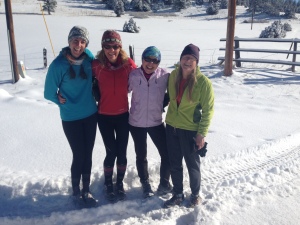 Layer up – there is nothing worse than being too cold on a run during Winter. With the technology available with fabrics these days, there is no reason to be feeling cold in even the most arctic like conditions Winter may throw at us! Start with a wicking base layer, made from a technical material that will wick sweat and moisture away from your body, leaving your core warmer. Cotton is not the best material to use, as it remains wet, helps keep you cooler, and has little insulative properties. I have a long sleeve base layer that is fairly snug, then a looser fitting long sleeve top, and finally a shell outer layer that helps protect against the wind. For legs – I wear shorts down to about 15F, anything colder than that I squeeze into a pair of compression tights. I am fortunate that my legs keep pretty warm, even here in the Rockies in Estes park, CO! I usually wear tracksters over the top on the way to a run to make sure I keep my leg muscles warm before I get going. Gloves can also be essential to winterize as well – I will often wear silk liners under a pair of gloves to add an extra layer to keep my fingers warm – blood supply in the cold can be restricted to our hands in colder weather, so this can really help. Remember that mittens are warmer than gloves when it’s really cold!
Layer up – there is nothing worse than being too cold on a run during Winter. With the technology available with fabrics these days, there is no reason to be feeling cold in even the most arctic like conditions Winter may throw at us! Start with a wicking base layer, made from a technical material that will wick sweat and moisture away from your body, leaving your core warmer. Cotton is not the best material to use, as it remains wet, helps keep you cooler, and has little insulative properties. I have a long sleeve base layer that is fairly snug, then a looser fitting long sleeve top, and finally a shell outer layer that helps protect against the wind. For legs – I wear shorts down to about 15F, anything colder than that I squeeze into a pair of compression tights. I am fortunate that my legs keep pretty warm, even here in the Rockies in Estes park, CO! I usually wear tracksters over the top on the way to a run to make sure I keep my leg muscles warm before I get going. Gloves can also be essential to winterize as well – I will often wear silk liners under a pair of gloves to add an extra layer to keep my fingers warm – blood supply in the cold can be restricted to our hands in colder weather, so this can really help. Remember that mittens are warmer than gloves when it’s really cold!
For your head, then there are many choices available for hats that have a combination of fleece inner and wind protection outer, again making sure that it can wick any sweat away from your head, and keep you warmer. Your specialty running store is the best place to check on all these items – if you haven’t geared up as a winter runner before, then this gives you the chance to make sure something fits and is going to be comfortable for you.
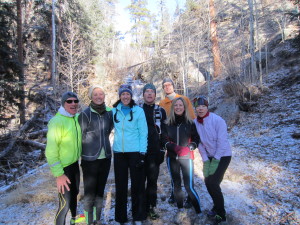 Quick feet – it always makes sense to slow down when conditions underfoot get slick, especially if you’re running in the dark as well! However you can help yourself by increasing your cadence, or the number of times your foot touches the ground. Having a quicker cadence will usually mean a shorter stride, and brings your foot-plant closer to your center of mass under your body, so giving you better balance, and giving you more control if it is slippery.
Quick feet – it always makes sense to slow down when conditions underfoot get slick, especially if you’re running in the dark as well! However you can help yourself by increasing your cadence, or the number of times your foot touches the ground. Having a quicker cadence will usually mean a shorter stride, and brings your foot-plant closer to your center of mass under your body, so giving you better balance, and giving you more control if it is slippery.
Traction – on the subject of feet, there are also some simple steps you can take to help you add traction to your running shoes. My favorite of the choices available is to use Icespikes – they are screws that you literally screw into the sole of your shoes, and then the screwheads give you grip on snow and ice. They are easy to install, don’t damage the shoes, and are good to run with on a variety of surfaces. I have tried YakTrax, and found they broke easily, and felt strange at times under my feet. You can also use sheet screws as well, see this link for expert advice on that topic from Matt Carpenter.
Shoes – of course you will need to keep your feet warm too! I usually wear a thicker sock in Winter, preferably a wool based variety from Balega or Smartwool. It’s also smart to think about wearing different shoes during Winter to help keep your feet warm. A shoe with an open mesh is great in Spring, Summer or Fall, it can be really uncomfortable in Winter. Anything made with GoreTex is going to help keep your feet snug, and remember that a thicker sock will mean a larger shoe possibly as well. Again, a specialty running store is your best place to go shopping for these.
Hydrate – make sure you hydrate effectively, especially for longer runs. Although you may not be sweating as much as you do in Summer, you are still losing fluids. Make sure to carry a bottle with you for longer runs – Ultraspire make some great options for hand held bottles, belts, and packs. You will also need to think about electrolyte replacement as well even though temps are cooler – Acli-Mate and NUUN are good options there.
Safety – run with someone else whenever you can. If you can only run alone, make sure that someone knows your route, and what time you are expected back. Let someone know that you are back as well. Carry your phone with you, just in case. For a longer run, think about carrying a small pack with a change of clothes just in case an accident happens while you’re out.
On windy days, set your run up so that you run into a headwind going out, and enjoy the tailwind coming home!
Once you have finished your run, get out of your damp clothes as quickly as possible. If you’re at home, then that’s pretty easy – if you’re out somewhere, have some warm, dry clothes ready in your car, or at a friend’s house.
Warm up before you head out – go through some dynamic movements as a pre-run routine so that your muscles will be warmer, and reduce the rick of injury, when you hit the cold air outside.
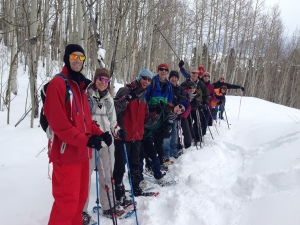 Cross training – some days it can be just impossible to get outside and run in safety and some comfort. I’m very thankful that the number of days this happens to us here in Estes Park are few! Some alternatives for you:
Cross training – some days it can be just impossible to get outside and run in safety and some comfort. I’m very thankful that the number of days this happens to us here in Estes Park are few! Some alternatives for you:
- pool running – this is one of the best cross training options you can choose, as the movement patterns mimic those of running. Most aquatic centers have the aqua jogger belts – if they don’t, they are pretty inexpensive to purchase, and will last for years – a great investment! See this post on pool running for more information.
- bike trainer or spinning – keeping your legs turning over on a bike trainer or spin cycle can be an excellent way of maintaining fitness levels, while also making sure your legs are mobile, and without any impact. Most leisure or recreation centers have classes or machines that you can use.
- swimming – another pool based option, swimming is a wonderful stress relief for the body as well as there is again no impact, while our body weight is supported. Unless you swim regularly, it can be tricky to gauge your effort level, so err on the side of caution and swim easy until you become more experienced.
- indoor track – some recreation centers have an indoor track, so that can be a great alternative place to work out – you may be time restricted though, so remember that even a 20 minute run helps to maintain fitness
- snowshoeing – a wonderful Winter cross training activity – a harder workout than a hike, while at the same time getting to explore in wild nature. Snowshoes are relatively cheap to rent, so you don’t need to invest in a pair you own. We use an old pair of trail shoes, and some gaiters to keep your feet dry
- be inventive – we have known Olympic level athletes in Boulder run laps in a large parking garage to keep mobile in inclement weather – watch out for traffic though, as drivers won’t be expecting to see a runner in that environment!
If your program calls for a hill workout, you can use stairs in a taller building – warm up first on a treadmill, rowing machine, or spin bike, then hit the stairs! You could also do this at a stadium of there’s no ice / snow on the steps?
We hope you keep healthy and mobile this Winter! Check out our training programs for Vacation Races, and our training camps for athletes of all abilities in Estes Park, Colorado!
If we can with your training for any Vacation Race in 2015, please contact us to let us know.
Happy Holidays!!

